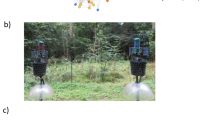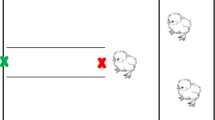Abstract
Understanding the early evolution of aposematic (warning) coloration has been a challenge for scientists, as a new conspicuous morph in a population of cryptic insects would have a high predation risk and would probably die out before local predators learnt to avoid it1,2,3,4. Fisher5 presented the idea of aggregation benefit through the survival of related individuals; however, his theory has been strongly debated6,7,8 as the mechanisms that favour grouping have never been explored experimentally with the incorporation of detectability costs. Here we create a comprehensive ‘novel world’ experiment with the great tit (Parus major) as a predator to explore simultaneously the predation-related benefits and costs for aposematic aggregated prey, manipulating both group size and signal strength. Our results show that grouping would have been highly beneficial for the first aposematic prey individuals surrounded by naive predators, because (1) detectability risk increased only asymptotically with group size; (2) additional detectability costs due to conspicuous signals were marginal in groups; (3) even naive predators deserted the group after detecting unpalatability (dilution effect); and (4) avoidance learning of signal was faster in groups. None of these mechanisms require kin selection.
This is a preview of subscription content, access via your institution
Access options
Subscribe to this journal
Receive 51 print issues and online access
$199.00 per year
only $3.90 per issue
Buy this article
- Purchase on Springer Link
- Instant access to full article PDF
Prices may be subject to local taxes which are calculated during checkout



Similar content being viewed by others
References
Endler, J. A. Frequency-dependent predation, crypsis and aposematic coloration. Phil. Trans. R. Soc. Lond. B 319, 505–523 (1988).
Guilford, T. in Insect Defenses. Adaptive Mechanisms and Strategies of Prey and Predators (eds Evans, D. L. & Schmidt, J. O.) 23–61 (State Univ. New York Press, New York, 1990).
Mallet, J. & Singer, M. C. Individual selection, kin selection, and the shifting balance in the evolution of warning colours: the evidence from butterflies. Biol. J. Linn. Soc. 32, 337–350 (1987).
Schuler, W. & Roper, T. J. Responses to warning coloration in avian predators. Adv. Study Behav. 21, 111–146 (1992).
Fisher, R. A. The Genetical Theory of Natural Selection (Clarendon, Oxford, 1930).
Alatalo, R. V. & Mappes, J. Tracking the evolution of warning signals. Nature 382, 708–710 (1996).
Tullberg, B. S., Leimar, O. & Gamberale-Stille, G. Did aggregation favour the initial evolution of warning coloration? A novel world revisited. Anim. Behav. 59, 281–287 (2000).
Alatalo, R. V. & Mappes, J. Initial evolution of warning coloration: comments on the novel world method. Anim. Behav. 60, F1–F2 (2000).
Lindström, L., Alatalo, R. V., Mappes, J., Riipi, M. & Vertainen, L. Can aposematic signals evolve by gradual change? Nature 397, 249–251 (1999).
Treisman, M. Predation and the evolution of gregariousness. I. Models for concealment and evasion. Anim. Behav. 23, 779–800 (1975).
Turner, G. F. & Pitcher, T. J. Attack abatement: a model for group protection by combined avoidance and dilution. Am. Nat. 128, 228–240 (1986).
Sillén-Tullberg, B. & Leimar, O. The evolution of gregariousness in distasteful insects as a defense against predators. Am. Nat. 132, 723–734 (1988).
Hamilton, W. D. Geometry for the selfish herd. J. Theor. Biol. 31, 295–311 (1971).
Lindström, L., Alatalo, R. V., Lyytinen, A. & Mappes, J. Predator experience on cryptic prey affects the survival of conspicuous aposematic prey. Proc. R. Soc. Lond. B 268, 357–361.
Gagliardo, A. & Guilford, T. Why do warningly-coloured prey live gregariously? Proc. R. Soc. Lond. B 251, 69–74 (1993).
Guilford, T. Is kin selection involved in the evolution of warning coloration? Oikos 45, 31–36 (1985).
Mallet, J. & Joron, M. Evolution of diversity in warning color and mimicry: polymorphisms, shifting balance, and speciation. Annu. Rev. Ecol. Syst. 30, 201–233 (2000).
Järvi, T., Sillén-Tullberg, B. & Wiklund, C. The cost of being aposematic. An experimental study of predation on larvae of Papilio machaon by the great tit Parus major. Oikos 36, 267–272 (1981).
Sillén-Tullberg, B., Wiklund, C. & Järvi, T. Aposematic coloration in adults and larvae of Lygaeus equestris and its bearing on mullerian mimicry: an experimental study on predation on living bugs by the great tit Parus major. Oikos 39, 131–136 (1982).
Marples, N. M., van Veelen, W. & Brakefield, P. M. The relative importance of colour, taste and smell in the protection of an aposematic insect Coccinella septempunctata. Anim. Behav. 48, 967–974 (1994).
Weismann, A. Studies in the Theory of Descent (Sampson, Low, Marston, Searle and Rivington, London, 1882).
Acknowledgements
We thank H. Nisu, L. Vertainen and the Academic Hobby Crafts Club for their help, and Konnevesi Research Station for the facilities. We also thank A. Chaine, G. Corrigan, A. Kause, R. Leimu, B. Lyon, A. Lyytinen, J. Tuomi and B. Weaver for valuable comments on earlier versions of the manuscript. This study was supported by the Academy of Finland. Authors after M.R. are in alphabetical order.
Author information
Authors and Affiliations
Corresponding authors
Rights and permissions
About this article
Cite this article
Riipi, M., Alatalo, R., Lindström, L. et al. Multiple benefits of gregariousness cover detectability costs in aposematic aggregations. Nature 413, 512–514 (2001). https://doi.org/10.1038/35097061
Received:
Accepted:
Issue Date:
DOI: https://doi.org/10.1038/35097061
This article is cited by
-
The debris-cloaking larva of Catapotia laevissima and the origin of defensive strategies in Anamorphidae and other Coccinelloidea (Coleoptera)
Organisms Diversity & Evolution (2023)
-
Personally rattled: a unique protocol to support the presence of personality and behavioral syndromes in rattlesnakes
Behavioral Ecology and Sociobiology (2023)
-
Colours as aggregation signals in Lepidoptera: Are Heliconius Müllerian mimics?
Evolutionary Ecology (2022)
-
Coevolution of group-living and aposematism in caterpillars: warning colouration may facilitate the evolution from group-living to solitary habits
BMC Ecology and Evolution (2021)
-
Social transmission in the wild can reduce predation pressure on novel prey signals
Nature Communications (2021)
Comments
By submitting a comment you agree to abide by our Terms and Community Guidelines. If you find something abusive or that does not comply with our terms or guidelines please flag it as inappropriate.



